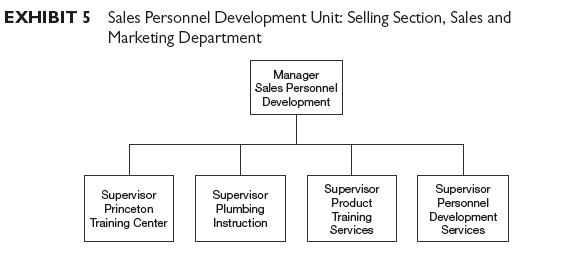The Plumbing and Heating Division of Stanamer Corporation made and sold plumbing fixtures and fittings, hydronic heating and cooling equipment, food-waste disposals, water softeners, and invalid bath lifts. The largest of seven corporate divisions, it operated fourteen plants from coast to coast. Toward the end of the year the general sales manager, J. B. Samson, was analyzing a problem concerning an increase in the size of the sales force. (See Exhibit 1 for Selling Section organization.) The budget for the next year provided funds for adding fifteen salespeople, and Samson compared two alternatives: (1) hiring sales personnel with previous sales experience in the field and (2) following the company traditional practice of hiring and training inexperienced persons.
Stanamer led the plumbing and heating industry in sales; its sales of $600 million were double those of the nearest competitor. Well known and respected, the company’s market share was estimated at 50 percent. Although its position was enviable, company management recognized the dangers of complacency, particularly as competition stiffened and the market share showed signs of declining.
Activity in the home-building industry, the largest market for plumbing and heating supplies, had fallen off. There were predictions that new hous-ing starts in the first half of the current year would be below the previous year’s level; however, an upturn was expected. When new housing starts dropped, total demand for plumbing and heating products also declined; consequently, competition for available business increased. Most firms moved to hire additional sales personnel to provide more intensive market coverage. Samson’s decision to hire fifteen additional salespeople was made for the short-term objective of reducing excess inventory. If housing starts recovered, top management might question the value of having fifteen extra persons, since in such circumstances Stanamer normally received sufficient business to support its full productive capacity.

The company’s products were of high quality and as such commanded prices about 10 percent above those of competitors. All promotion emphasized the superior product quality. Company sales-training sessions, focusing on product information and selling techniques, also emphasized the price-quality relationship.
Stanamer’s sales force sold exclusively through wholesale plumbing and heating distributors. The 250-person force called upon 1,400 wholesalers, who, in turn, sold through 50,000 contractors and plumbers. Sales personnel worked out of twenty-three sales offices located in some but not all of thirteen sales districts. (See Exhibits 2, 3, and 4 for the organizations of the various types of typical sales districts.)
District sales managers performed administrative duties and reported directly to the general sales manager. Their responsibilities included recruiting and training of the sales staff. However, the general sales manager determined the number and the qualifications of those hired.



The average salesperson wrote orders totaling from $2,400,000 to $3,600,000 annually. Each received a straight salary of $20,000 to $50,000 per year. Sales personnel maintained contact with distributors and assisted them in inventory control, in the training of their sales staff, and in the use of company promotional plans, programs, and materials. Sales personnel also promoted the use of Stanamer products through their contacts with home-builder and contractor trade associations. In addition, they promoted the use of the division’s products in talks with key personnel in hospital and school administrations, public utilities, and governmental agencies. They also inspected consumer products and made service calls.
Traditionally, Stanamer hired inexperienced people and put them through a six-month program. Sales recruits spent the first three months becoming acquainted with the company’s products and policies. They then attended a formal three-month program emphasizing advanced product knowledge and sales techniques. Training costs amounted to approximately $2,500 per person. Once out of training, new salespersons generally became fully operational and productive in from three to six months. (See Exhibit 5.)
To lure salespeople with field experience away from competitors required starting salaries averaging $20,000 annually. Also, considerable recruiting time and effort were involved, and there was the danger that competition might reciprocate. People with previous field experience usually became fully operational Stanamer sales personnel in about one month.

Samson wanted to hire the fifteen additional people, but he was not certain whether he should concentrate on those with or without previous selling experience in the industry.
Source: Richard R. Still, Edward W. Cundliff, Normal A. P Govoni, Sandeep Puri (2017), Sales and Distribution Management: Decisions, Strategies, and Cases, Pearson; Sixth edition.

Lovely just what I was searching for.Thanks to the author for taking his time on this one.